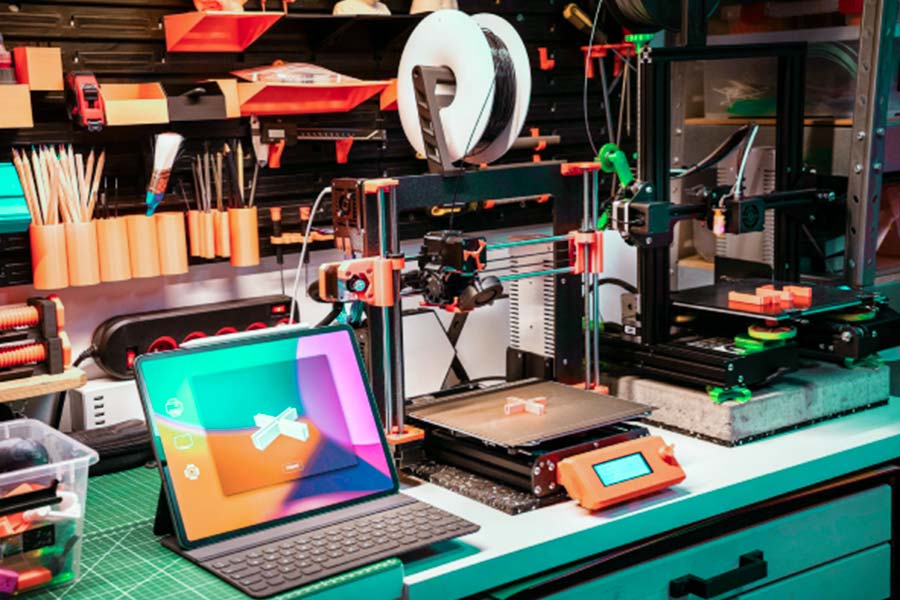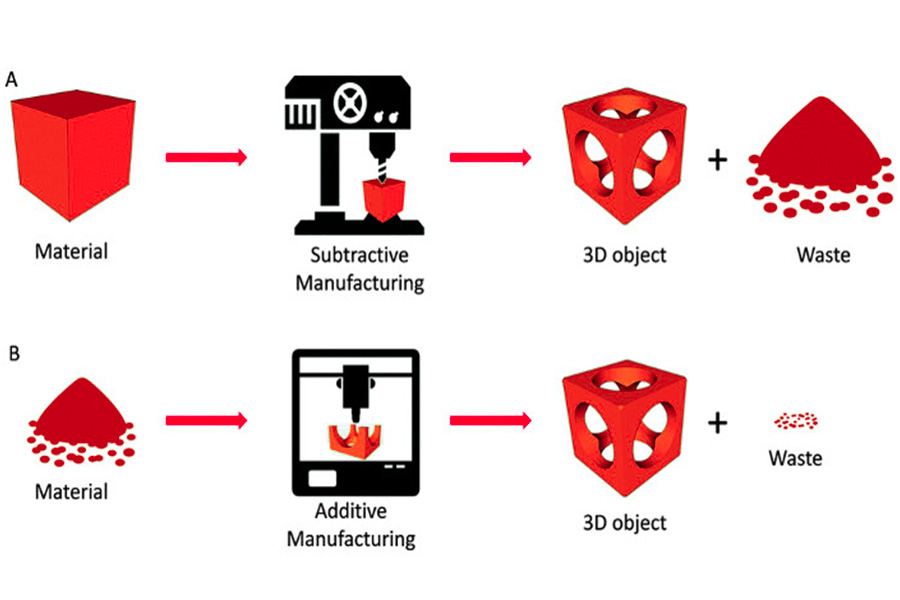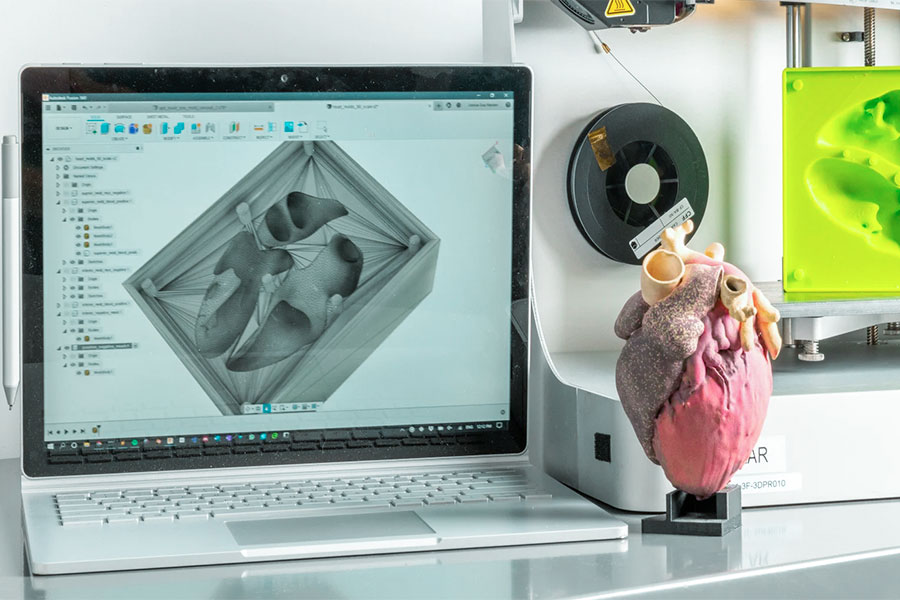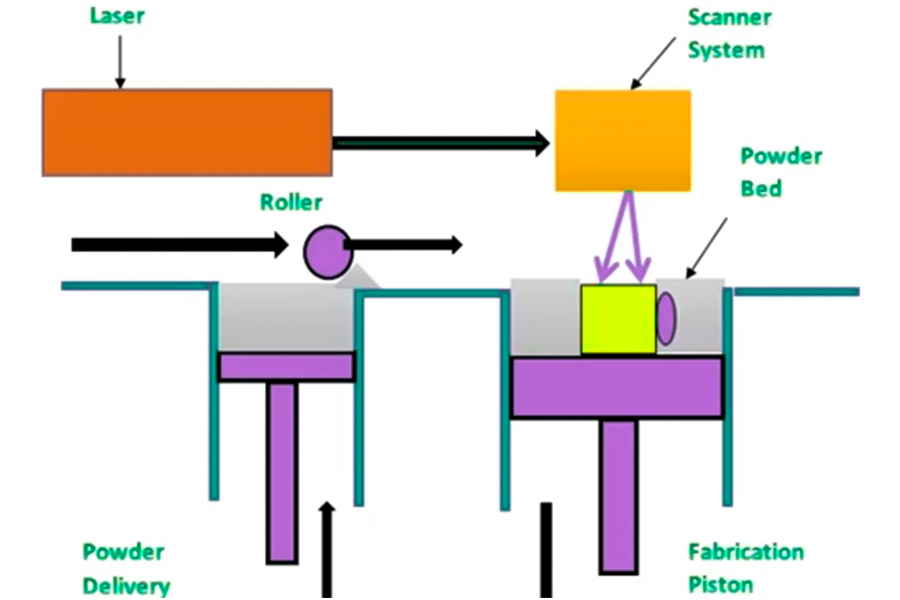In the field of modern industrial design, rapid prototyping have become the core bridge between conceptual innovation and physical verification. In essence, digital modeling is a deep fusion of physical manufacturing technology, which converts abstract design into tangible and measurable physical models to quickly validate product functionality, aesthetics and practicability in the early stages of product development. This process not only depends on high-precision machining equipment, but also requires a profound understanding of material properties, process logic and iterative mechanisms.
JS provides rapid prototype services, integrates additive manufacturing (e.g. SLA/DLP) and CNC machining technologies, and rapidly iterates metal composite components in the development of robotic joint prototypes, successfully compressing design validation cycle to 60% of the industry average. Drawing on its experience with more than 1,000 highly complex orders a year, JS is redefining the role of rapid prototyping technology in high-end manufacturing-not only as a laboratory tool, but also as an infrastructure for innovation through interdisciplinary collaboration.
What is the core definition of rapid prototyping?
Prototyping is the key process of transforming a digital design system into a physical model to verify functionality, aesthetics and practicality. At its core is the iteration of design through fast, low-cost and efficient rapid mockup to identify potential problems and optimize solutions in the early stages of product development. Prototypes don't just mean manufacturing physical objects, but bridging the gap between concept and reality through physical verification. Especially in the process of complex system development, structural defects, human-machine interaction contradiction or material performance limitations which cannot be reflected in drawings will be exposed.
Modern prototyping technology combines additive manufacturing with CNC machining technology, breaks through the limitation of single material, realizes rapid molding of metal-plastic hybrid structure, and further expands its application boundaries in aerospace, robotics and other high-end fields modern prototyping.

What are the 5 steps of rapid prototyping?
1.Concept stage: Clarity of requirements and objectives
By means of market research, user interviews, etc., the core requirements of the product are determined, and the functions, performance and cost boundaries of the prototype are determined. At this stage, it is necessary to clarify whether a rapid prototypes is needed to validate key design assumptions, such as structural feasibility or user experience.
2.Design phase: Digital modelling and optimization
Create 3D models using CAD software and output files in formats such as STL/STEP. The designer will optimize the design through parametric adjustments and simulation analysis (e.g. stress testing, dynamics simulation), and initially assess whether this can be achieved by rapid prototyping technology.
3.Construction phase: Rapid Prototyping
Choose the appropriate process and material to make the prototype:
- 3D printing: Suitable for complex geometric structures (e.g. photosensitive resin SLA, nylon powder SJS).
- CNC machining: Used for metal or high precision plastic parts (such as aluminum alloy, ABS).
- Mixing technology: Combining printing and cutting techniques to improve surface quality.
At the heart of this phase is the efficient production of rapid prototypes, usually with the first version completed in 1-3 days.
4.Test phase: Multidimensional validation and data collection
Full testing of rapid prototypes:
- Functional testing: Validation of mechanical properties (such as load-bearing, sealing, etc.) and stability of electronic systems.
- User testing: Collect feedback from target users through interactive prototypes, such as UI models.
- Environmental testing: Simulation of durability under extreme temperature, humidity or vibration conditions.
Test results need to be recorded quantitatively (e.g. deformation and wear rates) and compared with design indicators.
5.Improvement stage: iterative optimization and finalization
Adapt CAD models based on test data to optimize weaknesses (e.g. enhance structural strength and correct tolerance deviations) in a targeted manner. Repeat the rapid prototyping process to create a new version of the prototype until all validation criteria are met. The final prototype will serve as a benchmark for production of molds or engineering drawings to ensure consistency in mass production.
By designing and manufacturing test loop, rapid prototyping can shorten traditional development cycles by over 50% and single iteration costs by 80%. They are particularly suitable for rapid development of highly uncertainty projects such as medical devices and smart hardware.
What are the types of commonly used prototyping models?
1.Concept validation prototyping model: Core design concepts are validated by rapid prototyped models, which are often constructed quickly with low-cost materials (e.g. cardboard and foam) and focus on the feasibility of basic concepts such as product form and interactive logic.
2.Functional prototyping model: Prototyping tests focusing on specific functional modules, such as mechanical structural strength, electronic system stability, or efficiency of software algorithm, usually using techniques such as 3D printing and CNC machining to achieve accurate restore of key components.
3.Visual prototyping model: With appearance as the core objective, the prototyped is implemented by high-precision 3D printing or CNC engraving technology, showing product color matching, material texture and human-machine ratio. It is commonly used in visually-oriented fields such as consumer electronics and car interiors.
4.Interactive prototyping model: Integrates hardware components such as sensors and motors, builds physical models with basic operating functions, supports users to experience interaction process directly (e.g. button feedback and screen touch), and is widely used in intelligent hardware development.
5.User Testing Prototype Model: A trial version of a prototyped designed for a target user group that collects user experience data through A/B testing, scenario simulation, and other methods, often combined with rapid iterative optimization to improve product usability.
How to choose a suitable rapid prototyping technology?
Core decision-making factors
1.Prototype purpose
- Functional verification: CNC machining or metal 3D printing (e.g. SLM) should be given priority when subjected to mechanical load.
- Appearance verification: When emphasizing surface smoothness, light curing 3D printing (SLA) or CNC engraving can be selected.
- User testing: Silicone replication or flexible material printing (TPU) is recommended when assembly interaction are required.
2.Material needed
- Plastic prototype: ABS, PLA (FDM)、 Nylon (SLS), transparent resin (SLA).
- Metal prototypes: Aluminum alloy (CNC), Titanium alloy (SLM), Stainless steel (DMLS).
- Composite materials: Carbon Fiber Reinforced Nylon (SLS), Glass Fiber (CNC).
3.Cost budget
- Low-cost rapid verification: FDM ($10-40 perpiece), SLA ($40-80 perpiece).
- Precision requirements: SLA (± 0.05mm), SLS (± 0.1mm).
- Mass test production: CNC machining (unit price decreases with quantity).
4.Delivery times
- Desperate requirement: 3D printing (1-2 days), silicone replication (3-5 days).
- Precision machining: CNC machining (5-10 days), metal printing (7-14 days).
Comparison of mainstream technologies and applicable scenarios
| Technical type | Material type | Accuracy | Cost | Production speed | Typical application |
| FDM |
PLA/ABS/Nylon
|
±0.1-0.3mm | Low | Fast | Functional prototypes and simple structural components. |
| SLA | Photosensitive resin | ±0.05mm | Centre | Faster | Appearance verification, transparent parts, precision components. |
| SLS | Nylon/composite material | ±0.1mm | Tall | Centre | Fully functional and lightweight. |
| CNC machining | Metal/Plastic | ±0.01-0.05mm | Highest | Slow | High intensity testing and final confirmation before mass production. |
| Silicone replication mold | Silicone mold+PU resin | ±0.2-0.5mm | Low (batch) | Fast | Prototype model and small-scale pilot production. |
What are the differences between 3D printing and CNC prototyping?
In the field of rapid prototyping, 3D printing and CNC prototyping are two mainstream technologies that differ greatly in their manufacturing principles, material applicability and process characteristics:
1.Manufacturing principles
- 3D printing (additive manufacturing): By stacking materials (such as plastics and metal powder) in layers to form 3D, JS utilizes metal laser melting (SLM) and polymer SLA techniques for complex geometric structures.
- CNC machining (subtractive manufacturing): Cutting raw materials (such as metal and plastic) with cutting tools to remove excess parts, relying on tool path programming, suitable for high-precision functional parts. JS is equipped with five axis CNC machine tools, which can realize complex contour machining of precision die steel, aluminum alloy and other materials.
2.Material Applicability
- 3D printing: Material options are limited (commonly ABS, PLA, titanium alloys, etc.), and some materials have weak mechanical properties.
- JS provides more than 50 materials (metals, plastics, composites) such as aerospace grade aluminum alloys and high temperature resistant engineering plastics to meet industrial grade strength and corrosion resistance requirements.
- CNC machining: has a wide range of material adaptability, can process hard alloys (such as stainless steel, titanium alloys) and high-toughness materials (such as carbon fiber).
- JS technology Highlights: Its CNC equipment supports complex surface machining, in which case it achieves a 0.02mm thin-walled structure for medical equipment, demonstrating material processing capabilities.
3.Differences in process characteristics
| Dimensions | Advantages of 3D Printing | CNC advantages | JS Technology Balance Point |
| Material utilization rate | Reduce material waste (only what is needed). | High material waste (processing allowance required). | JS reduces CNC waste rate through smart path planning, and 3D printing supports metal powder recycling. |
| Surface quality | Surface roughness (Ra 50-200μm) requiring reprocessing. | Surface smoothness (Ra 0.8-3.2 μm). | JS's specialized post-processing equipment can optimize the surface roughness of 3D printed parts to Ra 1.6 μm. |
| Processing accuracy | ± 0.1-0.5mm (depending on model). | ± 0.02-0.1mm (up to ± 0.005mm high-precision machine tools). | Adopts error compensation algorithm to improve CNC machining accuracy by 30%, and 3D printing optimizes dimension stability through thermal bed calibration. |
| Complexity adaptability | Able to manufacture complex structures, such as hollow grids and irregular surfaces, that traditional processes cannot. | Suitable for general geometry and requires additional thin wall/suspension support. | JS Innovative hybrid manufacturing Model: CNC rough machining + 3D Printing Fine Features, Balanced Efficiency and Accuracy. |
- Choose 3D printing: When requirements focus on quick iterations, complex structure validation, or low-cost trial and error.
- Select CNC prototyping: When the goal is functional testing, high precision production preparation, or material performance validation.

Which industries rely the most on rapid prototyping technology?
According to the characteristics of online CNC processing and 3D printing business of JS, the application of rapid prototyping technology is analyzed below:
1.JS technology association:
- Lightweight aluminum alloy/carbon fiber prototypes available to support quick iterations of streamlined components.
- 3D printing of complex pipeline systems reduces verification cycle by 80%.
- CNC precision machining of Automotive Electronic connector molds.
2.Industry demands:
- Structural verification of battery assembly of new energy vehicle.
- Rapid testing of self-driving sensor bracket.
- Conduct exterior reviews of internal parts prior to mass production.
1.JS technology association:
- Titanium alloy/ superalloy prototypes meet FAA certification requirements.
- Precision casting mold production reduces research and development cycle by 50%.
- Wind tunnel testing model of complex aerodynamic profile.
2.Industry demands:
- Verification of prototype engine turbine blades.
- Functional testing of satellite antenna deployment mechanism.
- Mechanical simulation of spacecraft docking mechanism.
Medical equipment
1.JS technology association:
- Biocompatible material Custom Implant Prototypes.
- Surgical simulator 3D printing (bone/organ models).
- Customized rehabilitation equipment for fast delivery.
2.Industry demands:
- Verification frictional properties of artificial joints.
- Dental implant bite test.
- Pressure Distribution Analysis customized orthotics.
1.JS technology association:
- 50+material libraries support concept validation.
- Full-color 3D-printed appearance evaluation model.
- Rapid casting master mold production (silicone mold/resin mold).
2.Industry demands:
- Home product ergonomics testing of household products.
- Verification the interior color scheme for transport vehicles.
- Robot joint motion simulation.

How to control the cost of prototype production?
Prototype production cost control requires comprehensive consideration of materials, production, post-production maintenance and other factors, the following are the main strategies:
| Indicators | Industry average | JS technical indicators | Increase amplitude |
| Single prototype cost | $120 | $72 | 40% ↓ |
| First time yield | 68% | 91% | 34% ↑ |
| Environmental impact factors | 0.72 (high energy consumption/pollution) | 0.35 (Green Manufacturing) | 51% ↓ |
| Material utilization rate | 45%-60% | 85%-92% | 35%-50% ↑ |
| Processing cycle | 12-24 hours | 6-18 hours | 30%-50% ↓ |
| Scrap rate | 8%-15% | ≤1% | 85%-94% ↓ |
| As a proportion of labour costs | 25%-35% | 12%-18% | 30%-45% ↓ |
| Maintenance costs (10,000/year) | 15-25 | 8-12 | 40%-55% ↓ |
Core Technical of Cost Control in JS Company
1.Material recycling system
- Metal powder recycling line established (92% SLM process waste powder reuse rate)
- Engineering Plastic Regeneration particle technology Developed (ABS/PC recycled material performance retention rate ≥90%)
2.Intelligent process optimization
- AI parameter recommendation system: Automatically selecting the optimal processing parameter combination based on historical data.
- Dynamic cutting force compensation: Reduce tool wear and prolong tool service life by 3 times.
3.Digital quality control
- Online Coordinate Measuring: First inspection time reduced from 2 hours to 15 minutes.
- Digital twin analogue: 87% of potential design defects identified early.
4.Green manufacturing technology
- Dry cutting techniques: 100% reduction in coolant usage and 28% reduction in energy consumption.
- Low temperature sintering process: Sintering temperature from traditional 1200°C to 600°C, energy saving 45%..
5.Flexible production system
- Fast die changing device: CNC die changing time from 4 hours to 30 minutes.
- Intelligent warehouse management: Material turnover efficiency increased by 60%.
Summary
In the process of modern product development, rapid prototyping redefine the transformation path from concept to reality by iterating the prototyping model. Whether additive manufacturing or subtractive processes, the core prototyping meaning is to verify the feasibility of design with the most minimum cost and shortest cycle, and accelerate innovation loop cycle. From the sleek appearance of consumer electronics to high-performance components in aerospace, rapid prototype technology continues to push the boundaries of materials and processes, visualizing complex structures and making functionality testable. In the future, with the deep integration of intelligent algorithms and green manufacturing, prototyping models will be more deeply integrated into the life cycle of enterprise development, becoming a strategic tool for enterprises to deal with market uncertainty and continuously push industry innovation to agility and precision.
Disclaimer
The content of this page is for informational purposes only.JS SeriesNo representations or warranties of any kind, express or implied, are made as to the accuracy, completeness or validity of the information. It should not be inferred that the performance parameters, geometric tolerances, specific design features,material quality and type or workmanship that the third-party supplier or manufacturer will provide through the jusheng network. This is the responsibility of the buyerAsk for a quote for partsto determine the specific requirements for these parts.please Contact us Learn more information.
JS Team
JS is an industry-leading companyFocus on custom manufacturing solutions. With over 20 years of experience serving more than 5,000 customers,we focus on high precisionCNC machining,Sheet metal fabrication,3D printing,Injection molding,metal stamping,and other one-stop manufacturing services.
Our factory is equipped with more than 100 state-of-the-art 5-axis machining centers and is ISO 9001:2015 certified. We provide fast, efficient and high-quality manufacturing solutions to customers in more than 150 countries around the world. Whether it's low-volume production or mass customization, we can meet your needs with the fastest delivery within 24 hours. chooseJS TechnologyIt means choosing efficiency, quality and professionalism.
To learn more, please visit our website:jsrpm.com
FAQs
1.Does prototype production require the addition of supporting structures?
Whether to add support structures to prototype production depends on the type of process. For example, when FDM and SLA are used to print suspension structures, temporary brackets need to be added to prevent deformation and should be removed and polished upon completion. Due to the self-supporting nature of the powder, SLS technology usually does not require additional support, but it can affect the smoothness of the surface and requires reprocessing.
2.What should we do if the surface of the rapid prototyping is rough?
rapid prototyping rough surfaces can be treated by grinding, sandblasting or chemical polishing. For example, 3D-printed parts use sandpaper or chemicals to remove layered patterns, CNC machining and polishing to improve smoothness and ensure that functional or appearance requirements are met.
3.How long does it take for prototype production?
prototype production time vary according to process and complexity: simple plastic components (e.g. FDM) can be completed in a matter of hours, metal components or precision structures (e.g. CNC) require 1-3 days, and post-processing (polishing/coating) takes 1-2 days. Small batch customization or complex design may prolong the cycle, and advance communication of specific requirements is recommended.
4.Can prototypes be used directly in mass production?
Prototypes usually need to be adjusted before mass production can begin. For example, 3D-printed parts may need to replace mass-produced materials,such as metals, while CNC prototypes may need to optimize molds. Direct conversion may cause performance or cost problems, and gradual verification is recommended.







